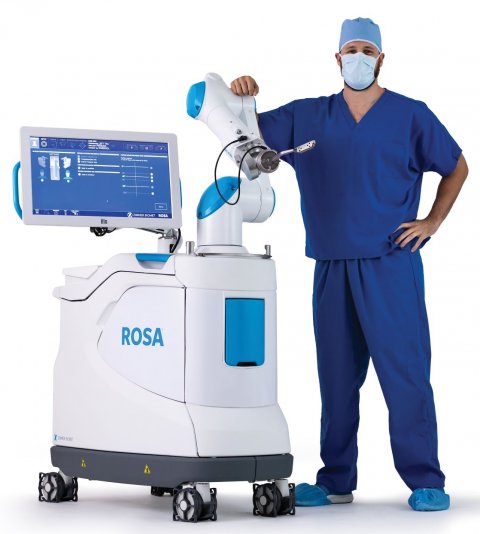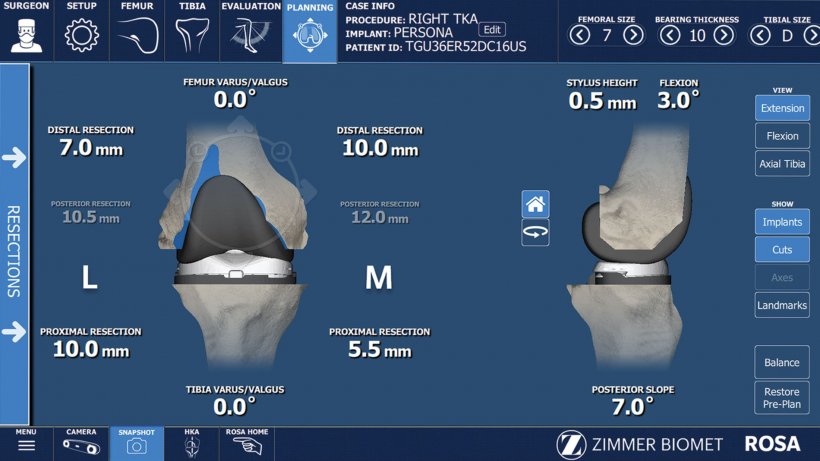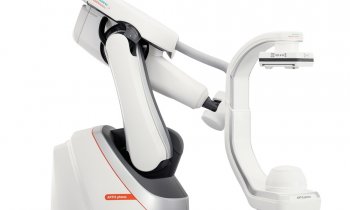Source: Zimmer Biomet
Article • Women in medical R&D
Innovation depends on more than just technical skills
Cécile Geneviève is one of the few women who lead research and development (R&D) at a major company and her increasingly female team reflects women’s growing interest in the field. But while gender balance is an important criterion, it takes a broad palette of skills to innovate to alleviate pain for millions of patients, she explained in an interview with Healthcare in Europe.
Report: Mélisande Rouger

Eagerness is what emerges from a conversation with Cécile Geneviève, a French mechanic and development engineer who leads system engineering at Zimmer Biomet Robotics. It’s easy to imagine how she inspires her team of 20 engineers to follow in her footsteps and deliver their best to innovate in surgery robotics. “I like to understand a complex subject and detail it, dissect it, and then control and learn from it,” she said. “This is what attracted me to physics and mathematics, and science in general. R&D presents a dynamism and energy in which I can constantly evolve.”
She started working in the automotive industry in the late 1990s, drawn by the many opportunities to learn and grow in a complex and technical world. In 2010, her focus switched to the medical device industry and robotic-assisted surgery and she never let go. “The pace of innovation and opportunity to deliver a service to patients and users is very exciting; it’s an area where so many things are happening right now.”
What makes a good team
Leadership positions continue to be dominated by men in many industries, often more so in technical departments. But the world is changing. An increasing number of women are taking an interest in R&D leadership, such as Liane Teplitsky, Vice President and General Manager of Technology & Data Solutions at Zimmer Biomet’s. “Gender divide is fading out,” Cécile said. “I don’t notice a difference in the way we work between France, Canada and the United States. An HR publication was sent out recently that showed almost no difference in salaries between men and women in our company. I think this helps to inspire more women to work in this field.”
For me, it’s crucial to offer equal opportunities to all qualified applicants, regardless of gender or background. Technical and soft skills, motivation and respect for others is what really matters
Cécile Geneviève
Cécile witnessed the change early on. When she studied mechanical engineering at the National Institute of Applied Sciences (INSA, in French) in Lyon back in the 1990s, 30% of her classmates were women. “This was the first time so many women joined that course,” she said. “Some areas, for example software engineering, remain male-dominated. There are just not enough female students in the pipeline.”
Cécile’s team now comprises 40% of women system engineers. The proportion wasn’t an objective but reflects a sense of fairness and desire to attract the right skills in her department, she explained. “I am very sensitive to the question of equality and, for me, it’s crucial to offer equal opportunities to all qualified applicants, regardless of gender or background. Technical and soft skills, motivation and respect for others is what really matters.” Cécile and her team work closely with healthcare professionals to speed the pace of innovation and expand the possibilities for successful treatment outcomes. “Collaborating with physicians, we’ve created a comprehensive inventory for joint reconstruction, bone and skeletal repair, sports and spinal injuries, and dental procedures available.”

There are more women in orthopedics than first thought and the number is growing. The Zimmer Biomet Institute has recently launched the Woman in Orthopedics program to support the trend.
Surgeons are very demanding partners regardless of gender. “They have very high expectations and that’s why the development of a product such as the ROSA robot is so interesting for engineers,” she said. “The key challenges are related to the variety of surgical techniques used by surgeons. We need to develop features that are flexible enough for good adaptability to these techniques, while achieving the highest level of quality for performance and safety.”
“Patient and user safety is at the center of our activities, and risk management and quality are a daily focus for R&D teams,” she said. “ROSA ONE Brain is a good example of this patient-focused work frame.” The robot assists surgeons in planning and performing complex neurosurgical procedures through a small drill hole in the skull. The technology enables surgeons to perform less invasive procedures than traditional craniotomies – enabling smaller incisions and potentially enhancing patient comfort. “The device may give access to a therapy for patients who could not have supported a conventional procedure, because of the operating time, for example the SEEG, which aims to identify epilepsy foci for drug resistant patients,” Cécile said.
Another innovation, ROSA ONE Spine, enables to perform minimally invasive surgeries and has been proven to significantly reduce blood loss, lower infection rates and reduce complications. Studies show that use of robotic guidance during spinal fusion significantly reduces radiation exposure and length of stay.

Source: Zimmer Biomet
Technology is increasingly integrated in the operating room and robots are only one part of the equation. In the future, there will be a stronger integration between implants and technology, artificial intelligence and data insights, she believes. “Many devices and products are now robotic, connected and/or equipped with sensors: operating tables, lighting, imaging systems, microscopes, drills and reamers. All these devices will work as integrated units, delivering new sources of data insights to further improve patient care.”
Robotics is a part of ZBEdge, Zimmer Biomet’s suite of integrated digital and robotic technologies, which has been engineered to deliver data-powered clinical insights, shared seamlessly across the patient journey. “Data processing and artificial intelligence make it possible to re-run surgeries for training purposes, share a specific technique with other surgeons or train young surgeons. The possibilities are endless, and that’s what makes it so exciting,” she concluded.
Profile:
Cécile Genevieve leads a team of R&D engineers at Zimmer Biomet Robotics, a global musculoskeletal healthcare leader. Based in Montpellier, France, Cécile and her team are developing robotic solutions that assist surgeons to treat patients suffering from disorders of, and injuries to bones, joints its supporting soft tissues and performing complex neurosurgical procedures.
15.07.2021







